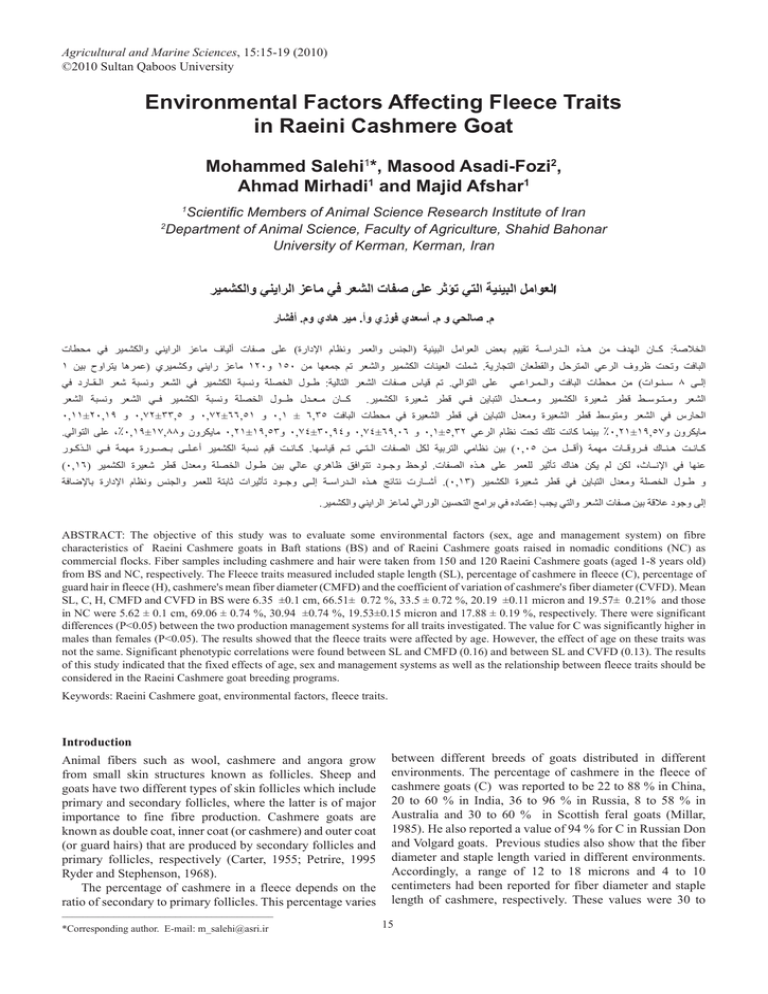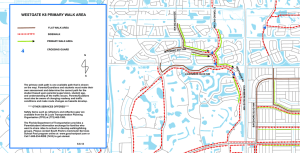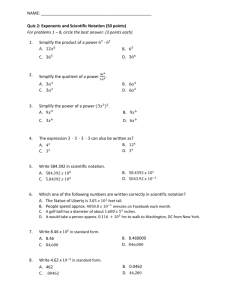Environmental Factors Affecting Fleece Traits in Raeini Cashmere Goat Mohammed Salehi
advertisement

Agricultural and Marine Sciences, 15:15-­19 (2010) ©2010 Sultan Qaboos University Environmental Factors Affecting Fleece Traits in Raeini Cashmere Goat Mohammed Salehi1*, Masood Asadi-­Fozi2, Ahmad Mirhadi1 and Majid Afshar1 Scientific Members of Animal Science Research Institute of Iran Department of Animal Science, Faculty of Agriculture, Shahid Bahonar University of Kerman, Kerman, Iran 1 2 ﺍاﻟﻌﻮﺍاﻣﻞ ﺍاﻟﺒﻴﯿﺌﻴﯿﺔ ﺍاﻟﺘﻲ ﺗﺆﺛﺮ ﻋﻠﻰ ﺻﻔﺎﺕت ﺍاﻟﺸﻌﺮ ﻓﻲ ﻣﺎﻋﺰ ﺍاﻟﺮﺍاﻳﯾﻨﻲ ﻭوﺍاﻟﻜﺸﻤﻴﯿﺮ ﺃأﻓﺸﺎﺭر. ﻣﻴﯿﺮ ﻫﮬﮪھﺎﺩدﻱي ﻭوﻡم. ﺃأﺳﻌﺪﻱي ﻓﻮﺯزﻱي ﻭوﺃأ. ﺻﺎﻟﺤﻲ ﻭو ﻡم.ﻡم ﻭوﺍاﻟﻜﺸﻤﻴﯿﺮ ﻓﻲ ﻣﺤﻄﺎﺕت ﻛــﺎﻥن ﺍاﻟﻬﮭﺪﻑف ﻣﻦ ﻫﮬﮪھــﺬﻩه ﺍاﻟــﺪﺭرﺍاﺳــﺔ ﺗﻘﻴﯿﻴﯿﻢ ﺑﻌﺾ ﺍاﻟﻌﻮﺍاﻣﻞ ﺍاﻟﺒﻴﯿﺌﻴﯿﺔ )ﺍاﻟﺠﻨﺲ ﻭوﺍاﻟﻌﻤﺮ ﻭوﻧﻈﺎﻡم ﺍاﻹﺩدﺍاﺭرﺓة( ﻋﻠﻰ ﺻﻔﺎﺕت ﺃأﻟﻴﯿﺎﻑف ﻣﺎﻋﺰ ﺍاﻟﺮﺍاﻳﯾﻨﻲ:ﺍاﻟﺨﻼﺻﺔ ١۱ ﺑﻴﯿﻦ ﻣﺎﻋﺰ ﺭرﺍاﻳﯾﻨﻲ ﻭوﻛﺸﻤﻴﯿﺮﻱي )ﻋﻤﺮﻫﮬﮪھﺎ ﻳﯾﺘﺮﺍاﻭوﺡح ١۱٢۲٠۰ ﻭو١۱٥٠۰ ﺷﻤﻠﺖ ﺍاﻟﻌﻴﯿﻨﺎﺕت ﺍاﻟﻜﺸﻤﻴﯿﺮ ﻭوﺍاﻟﺸﻌﺮ ﺗﻢ ﺟﻤﻌﻬﮭﺎ ﻣﻦ. ﺍاﻟﺘﺠﺎﺭرﻳﯾﺔ ﻭوﺗﺤﺖ ﻇﺮﻭوﻑف ﺍاﻟﺮﻋﻲ ﺍاﻟﻤﺘﺮﺣﻞ ﻭوﺍاﻟﻘﻄﻌﺎﻥن ﺍاﻟﺒﺎﻓﺖ ﻓﻲ ﺍاﻟﺨﺼﻠﺔ ﻭوﻧﺴﺒﺔ ﺍاﻟﻜﺸﻤﻴﯿﺮ ﻓﻲ ﺍاﻟﺸﻌﺮ ﻭوﻧﺴﺒﺔ ﺷﻌﺮ ﺍاﻟــﻘــﺎﺭرﺩد ﻃــﻮﻝل: ﺗﻢ ﻗﻴﯿﺎﺱس ﺻﻔﺎﺕت ﺍاﻟﺸﻌﺮ ﺍاﻟﺘﺎﻟﻴﯿﺔ.ﻋﻠﻰ ﺍاﻟﺘﻮﺍاﻟﻲ ﻭوﻧﺴﺒﺔ ﺍاﻟﺸﻌﺮ ﺍاﻟﺨﺼﻠﺔ ﻭوﻧﺴﺒﺔ ﺍاﻟﻜﺸﻤﻴﯿﺮ ﻓــﻲ ﺍاﻟﺸﻌﺮ ﻛــﺎﻥن ﻣــﻌــﺪﻝل ﻃــﻮﻝل ﻣﺤﻄﺎﺕت ﺍاﻟﺒﺎﻓﺖ ﻭوﺍاﻟــﻤــﺮﺍاﻋــﻲ ﻣﻦ ( ﺳــﻨــﻮﺍاﺕت٨۸ ﺇإﻟــﻰ . ﺍاﻟﻜﺸﻤﻴﯿﺮ ﻭوﻣــﻌــﺪﻝل ﺍاﻟﺘﺒﺎﻳﯾﻦ ﻓــﻲ ﻗﻄﺮ ﺷﻌﻴﯿﺮﺓة ﺍاﻟﻜﺸﻤﻴﯿﺮ ﺷﻌﻴﯿﺮﺓة ﺍاﻟﺸﻌﺮ ﻭوﻣــﺘــﻮﺳــﻂ ﻗﻄﺮ ٠۰,١۱١۱±٢۲٠۰,١۱٩۹ ﻭو٠۰,٧۷٢۲±٣۳٣۳,٥ ﻭو ٠۰,٧۷٢۲±٦٦,٥١۱ ﻭو٠۰,١۱ ± ٦,٣۳٥ ﻣﺤﻄﺎﺕت ﺍاﻟﺒﺎﻓﺖ ﻓﻲ ﺍاﻟﺸﻌﻴﯿﺮﺓة ﻭوﻣﻌﺪﻝل ﺍاﻟﺘﺒﺎﻳﯾﻦ ﻓﻲ ﻗﻄﺮ ﺍاﻟﺸﻌﻴﯿﺮﺓة ﺍاﻟﺤﺎﺭرﺱس ﻓﻲ ﺍاﻟﺸﻌﺮ ﻭوﻣﺘﻮﺳﻂ ﻗﻄﺮ . ﻋﻠﻰ ﺍاﻟﺘﻮﺍاﻟﻲ،٬٪٠۰,١۱٩۹±١۱٧۷,٨۸٨۸ ﻣﺎﻳﯾﻜﺮﻭوﻥن ﻭو ٠۰,٢۲١۱±١۱٩۹,٥٣۳ ﻭو٠۰,٧۷٤±٣۳٠۰,٩۹٤ ﻭو ٠۰,٧۷٤±٦٩۹,٠۰٦ ﻭو ٠۰,١۱±٥,٣۳٢۲ ﺗﺤﺖ ﻧﻈﺎﻡم ﺍاﻟﺮﻋﻲ ﺑﻴﯿﻨﻤﺎ ﻛﺎﻧﺖ ﺗﻠﻚ٪٠۰,٢۲١۱±١۱٩۹,٥٧۷ﻣﺎﻳﯾﻜﺮﻭوﻥن ﻭو ﻓــﻲ ﺍاﻟــﺬﻛــﻮﺭر ﻣﻬﮭﻤﺔ ﻧﺴﺒﺔ ﺍاﻟﻜﺸﻤﻴﯿﺮ ﺃأﻋــﻠــﻰ ﺑــﺼــﻮﺭرﺓة ﻗﻴﯿﻢ ﻛــﺎﻧــﺖ. ﺍاﻟﺘﺮﺑﻴﯿﺔ ﻟﻜﻞ ﺍاﻟﺼﻔﺎﺕت ﺍاﻟــﺘــﻲ ﺗــﻢ ﻗﻴﯿﺎﺳﻬﮭﺎ ﻧﻈﺎﻣﻲ ( ﺑﻴﯿﻦ٠۰,٠۰٥ ﻣــﻦ )ﺃأﻗـــﻞ ﻛــﺎﻧــﺖ ﻫﮬﮪھــﻨــﺎﻙك ﻓــﺮﻭوﻗــﺎﺕت ﻣﻬﮭﻤﺔ (٠۰,١۱٦) ﺍاﻟﻜﺸﻤﻴﯿﺮ ﻭوﻣﻌﺪﻝل ﻗﻄﺮ ﺷﻌﻴﯿﺮﺓة ﻇﺎﻫﮬﮪھﺮﻱي ﻋﺎﻟﻲ ﺑﻴﯿﻦ ﻃــﻮﻝل ﺍاﻟﺨﺼﻠﺔ ﻟﻮﺣﻆ ﻭوﺟــﻮﺩد ﺗﺘﻮﺍاﻓﻖ. ﻟﻠﻌﻤﺮ ﻋﻠﻰ ﻫﮬﮪھــﺬﻩه ﺍاﻟﺼﻔﺎﺕت ﺗﺄﺛﻴﯿﺮ ﻟﻜﻦ ﻟﻢ ﻳﯾﻜﻦ ﻫﮬﮪھﻨﺎﻙك،٬ﻋﻨﻬﮭﺎ ﻓﻲ ﺍاﻹﻧـــﺎﺙث ﻭوﺟــﻮﺩد ﺗﺄﺛﻴﯿﺮﺍاﺕت ﺛﺎﺑﺘﺔ ﻟﻠﻌﻤﺮ ﻭوﺍاﻟﺠﻨﺲ ﻭوﻧﻈﺎﻡم ﺍاﻹﺩدﺍاﺭرﺓة ﺑﺎﻹﺿﺎﻓﺔ ﺇإﻟــﻰ ﻫﮬﮪھــﺬﻩه ﺍاﻟــﺪﺭرﺍاﺳــﺔ ﺃأﺷــﺎﺭرﺕت ﻧﺘﺎﺋﺞ.(٠۰,١۱٣۳) ﺷﻌﻴﯿﺮﺓة ﺍاﻟﻜﺸﻤﻴﯿﺮ ﻭو ﻃــﻮﻝل ﺍاﻟﺨﺼﻠﺔ ﻭوﻣﻌﺪﻝل ﺍاﻟﺘﺒﺎﻳﯾﻦ ﻓﻲ ﻗﻄﺮ . ﺍاﻟﺮﺍاﻳﯾﻨﻲ ﻭوﺍاﻟﻜﺸﻤﻴﯿﺮ ﺻﻔﺎﺕت ﺍاﻟﺸﻌﺮ ﻭوﺍاﻟﺘﻲ ﻳﯾﺠﺐ ﺇإﻋﺘﻤﺎﺩدﻩه ﻓﻲ ﺑﺮﺍاﻣﺞ ﺍاﻟﺘﺤﺴﻴﯿﻦ ﺍاﻟﻮﺭرﺍاﺛﻲ ﻟﻤﺎﻋﺰ ﺇإﻟﻰ ﻭوﺟﻮﺩد ﻋﻼﻗﺔ ﺑﻴﯿﻦ ِ BSTRACT: The objective of this study was to evaluate some environmental factors (sex, age and management system) on fibre A characteristics of Raeini Cashmere goats in Baft stations (BS) and of Raeini Cashmere goats raised in nomadic conditions (NC) as commercial flocks. Fiber samples including cashmere and hair were taken from 150 and 120 Raeini Cashmere goats (aged 1-­8 years old) from BS and NC, respectively. The Fleece traits measured included staple length (SL), percentage of cashmere in fleece (C), percentage of guard hair in fleece (H), cashmere's mean fiber diameter (CMFD) and the coefficient of variation of cashmere's fiber diameter (CVFD). Mean SL, C, H, CMFD and CVFD in BS were 6.35 ±0.1 cm, 66.51± 0.72 %, 33.5 ± 0.72 %, 20.19 ±0.11 micron and 19.57± 0.21% and those in NC were 5.62 ± 0.1 cm, 69.06 ± 0.74 %, 30.94 ±0.74 %, 19.53±0.15 micron and 17.88 ± 0.19 %, respectively. There were significant differences (P<0.05) between the two production management systems for all traits investigated. The value for C was significantly higher in males than females (P<0.05). The results showed that the fleece traits were affected by age. However, the effect of age on these traits was not the same. Significant phenotypic correlations were found between SL and CMFD (0.16) and between SL and CVFD (0.13). The results of this study indicated that the fixed effects of age, sex and management systems as well as the relationship between fleece traits should be considered in the Raeini Cashmere goat breeding programs. Keywords: Raeini Cashmere goat, environmental factors, fleece traits. Introduction Animal fibers such as wool, cashmere and angora grow from small skin structures known as follicles. Sheep and goats have two different types of skin follicles which include primary and secondary follicles, where the latter is of major importance to fine fibre production. Cashmere goats are known as double coat, inner coat (or cashmere) and outer coat (or guard hairs) that are produced by secondary follicles and primary follicles, respectively (Carter, 1955;; Petrire, 1995 Ryder and Stephenson, 1968). The percentage of cashmere in a fleece depends on the ratio of secondary to primary follicles. This percentage varies between different breeds of goats distributed in different environments. The percentage of cashmere in the fleece of cashmere goats (C) was reported to be 22 to 88 % in China, 20 to 60 % in India, 36 to 96 % in Russia, 8 to 58 % in Australia and 30 to 60 % in Scottish feral goats (Millar, 1985). He also reported a value of 94 % for C in Russian Don and Volgard goats. Previous studies also show that the fiber diameter and staple length varied in different environments. Accordingly, a range of 12 to 18 microns and 4 to 10 centimeters had been reported for fiber diameter and staple length of cashmere, respectively. These values were 30 to _________________________________________ *Corresponding author. E-­mail: m_salehi@asri.ir 15 Salehi and others 90 microns and 6 to 22 centimeters for the fiber diameter and staple length of the guard hair, respectively (Jin and Zhang, 1995). In addition, earlier studies had shown that the fleece traits including C, SL and CMFD were affected by age, sex, flock and birth type (Emami Mibodi et al., 1991;; Newman and Paterson, 1996;; Saghi and Shiri, 2004;; Zakheri, 1986). Therefore, the variation in the percentage of cashmere in fleece, fiber diameter and staple length which have been reported in these studies could be due to different production management systems as well as breed, sex, age, birth type and other environmental factors. However, no reports were found on fleece traits in Raeini cashmere goats. The main objective of this study was to investigate the effect of production management systems (semi intensive and extensive) on the quality and quantity of fibre production in Raeini cashmere goats. The effects of sex and age were investigated as well. Materials and Methods The fiber samples (20 gram) were taken from right mid-­ side of the goats (150 and 120 Raeini Cashmere goats in Baft rearing station (BS) and commercial flocks, respectively) following the procedure described by Hopkins (1990). Baft rearing Station is a farm which is close to a city named Baft. This city is situated in a province called Kerman in the southern part of Iran. This farm was used for research purposes on Raeini Cashmere goat under the semi-­intensive system (Haji Mohamadi, 1990). The other flocks (commercial flocks) in our study were considered under the extensive management system. These flocks were reared in pastures around the mountain area during the summer and migrated in flat areas during the winter. Fleece traits measured included the percentage of cashmere in fleece (C), the percentage of hair in fleece (H), staple length (SL), cashmere's mean fibre diameter (CMFD) and the coefficient of variation of cashmere's fibre diameter. The staple lengths were measured using a ruler with a susceptibility of 0.5 cm (Brown, 1958). Three or four locks were randomly chosen from different areas of each sample. Locks from each sample were individually washed with hot water (45°C) and a non-­ ionic detergent, rinsed in hot water and then dipped in a commercial solvent (dichloromethane alcohol) to remove any residual grease after washing. Care was taken to avoid disturbing the staple formation of the fibers and to minimize the loss of shorter fibers in the samples. Samples were then air-­dried overnight. Small amounts of samples were separated as sub-­samples for hand dehairing. First, a visual subjective test was used to separate the fine (cashmere) and coarse (hair) fibers. The weight of different fibers was determined by weighing, using an analytical balance accuracy of 0.0001 gram. The fine fibers were prepared for measurement with the projection microscope technique in accordance with ASTM D2130-­ 78 short–section procedure in order to determine the fibre 16 diameter. Each sample was compressed and fibers were cut at mid-­staple with a heavy-­duty cross-­section device to provide snippets 200-­300 micron in length. Over one hundred fibers from each sample were measured (Anonymous, 1982). The mean fiber diameter, standard deviation of fiber diameter and coefficients of variation of fiber diameter were measured. Data Analyses The following statistical model was used for the analysis by a general linear model (GLM) using SAS software package (SAS / STAT User’s Guide, 1987). IJKM where I IJKM K IJ IK th I is the effect of i sex; th K IJK JK is individual records on C, H, CMFD, CVCFD or SL; population mean; system; J is the effect of k age; IJ IJKM is the th J is the effect of j management is the interaction between sex and the management system; IK is the interaction between sex and age; is the interaction between the management system and age, ( ) IJK JK is the interaction between sex; age and management system; and ε m IJK is the residual effects. Results and Discussion Least-­square means for the fixed effects on fleece traits and simple statistics for C and CMFD are presented in Tables 1 and 2. The management system had a significant effect (P<0.05) on fleece traits. In comparison with the extensive system, the goats in the intensive system had longer staple, less C, more CMFD and more CVCFD. The maximum C (87.54 %) and the minimum CMFD (15.39 microns) belong to the extensive system (Table 2). The results show that more cashmere were produced in the extensive system in comparison with the intensive system. In addition, these cashmeres were finer (19.64 microns) than those in the intensive system (20.12 microns). Previous studies showed that there is a negative and high genetic correlation between CVFD and staple strength (Safari et al., 2005). Therefore, the cashmere produced in the commercial flocks had more strength than the BS. The values of 47.5±8.9 cm and 16.6±1.2 microns have been reported for SL and CMFD, respectively for Brown and Black Birjandi goats (Saghi and Shiri, 2004). In their study, flock, sex and management systems had significant effects on fleece traits. Age had a significant effect (P<0.05) on all fleece traits investigated in our study. Staple length, CMFD and CVFD were increased with age while the percentage of cashmere in the fleece (C) was changed in an irregular manner. No significant differences were observed between males and females in SL, CMFD and CVFD values, while sex had a significant (P<0.05) impact on C and relatively on H. Zakheri (1986) found that SL of cashmere and hair was significantly affected by sex and age. He had reported the values of 4.74 and 7.54 cm for cashmere and hair SL, respectively Environmental factors affecting fleece traits in Raeini Cashmere goat Table 1. Least square means and standard errors of fixed effects for SL (staple length, cm), C (percentage of cashmere in a fleece, %), H (percentage of guard hair in a fleece, %), CMFD (cashmere mean fiber diameter for cashmere, micron), CVFD (coefficient of variation of cashmere fibre diameter, %) . 53 217 SL NS 5.90 ± 0.16 6.03 ± 0.08 C * 71.7 ± 0.90 66.6 ± 0.59 Traits H * 28.1 ± 0.9 33.4 ± 0.6 CMFD NS 19.9 ± 0.19 19.8 ± 0.10 CVFD NS 19.1 ± 0.36 18.7 ± 0.16 Management System Station 150 Rural Flock 120 ** 6.35 ± 0.10 5.63 ± 0.10 * 66.49 ± 0.72 69.05 ± 0.74 * 33.45 ± 0.72 33.94 ± 0.74 * 20.12 ± 0.11 19.64 ± 0.15 * 19.56 ± 0.21 17.88 ± 0.19 Age Yearling 2 years 3 years 4 years 5 years 6 years 7 years 8 years 12 108 77 19 27 11 8 8 * 5.61 ± 0.41 6.04 ± 0.11 6.04 ± 0.12 6.38 ± 0.35 5.92 ± 0.23 5.56 ± 0.31 5.93 ± 0.27 6.54 ± 0.51 * 67.80 ± 2.00 69.33 ± 0.72 67.82 ± 1.05 66.84 ± 2.27 64.80 ± 1.80 66.01 ± 2.70 60.61 ± 3.17 63.11 ± 2.16 * 32.19 ± 2.00 30.66 ± 0.72 32.18 ± 1.05 32.66 ± 2.30 35.22 ± 1.80 33.98 ± 2.70 39.38 ± 3.17 36.89 ± 2.16 * 19.33 ± 0.50 19.73 ± 0.13 19.70 ± 0.17 19.98 ± 0.36 19.62 ± 0.40 20.51 ± 0.41 20.62 ± 0.55 21.01 ± 0.43 * 17.88 ± 0.54 18.39 ± 0.20 18.81 ± 0.25 18.75 ± 0.76 19.94 ± 0.52 19.46 ± 1.01 19.64 ± 1.37 20.51 ± 0.83 -­ -­ -­ -­ NS NS NS NS * NS NS NS * NS NS NS NS NS NS NS * NS NS NS Effects No. Sex Male Female Sex & flock Sex & age Flock & age Sex & flock & age *, **: Significant (P<0.05 & P<0.01). NS: Not Significant (P>0.05). Table 2. Simple statistics for C and MFDC. Traits Effects No. C CMFD Min Max Min Max Sex Male Female 53 217 55.50 41.20 87.60 86.50 16.90 15.40 22.80 23.24 Management System Station Rural Flock 150 120 41.61 41.23 86.48 87.54 16.09 15.39 23.25 22.85 Age Yearling 2 years 3 years 4 years 5 years 6 years 7 years 8 years 12 108 77 19 27 11 8 8 56.11 49.60 41.20 49.70 49.50 46.55 46.00 53.60 78.33 86.50 85.20 87.60 85.70 78.70 71.00 72.40 16.60 15.40 16.20 17.07 15.67 17.70 18.30 18.50 22.12 22.40 23.30 22.60 22.37 22.70 23.20 23.00 17 Salehi and others 3TAPLELENGTH#M Table 3. Phenotypic correlations between the fleece in male cashmere goats at yearling age and 5.02 and traits. 7.68 cm for females of the same age. The values for SL of cashmere and hair indicated an increase of SL at two years of age (5.38 and 6.23 cm, respectively). In this Character C H CMFD CVFD study, the mean fibre diameters of cashmere in male and SL -­0.05 0.05 0.16* 0.13* female goats at yearling age were 14.63 and 15.23 cm, respectively. The CMFD was increased to 16.8 microns C -­ -­1.0** 0.10 0.07 at 2 years of age. Emami Mibodi, et al. (1991) also found significant differences between males and females for C, H -­ -­0.10 -­0.07 SL and MCFD. Accordingly C, MCFD and SL of males CMFD -­ -­0.10 and females were of 63±10 %, 20.98±2.1 microns and 6.46±1.88 cm and 68±10 %, 19.4±1.76 % and 6.48 ±1.78, *, **: Significant (P<0.05 & P<0.01). respectively. The estimation of phenotypic correlation between fleece traits is presented in Table 3. Significant phenotypic (a) correlations were found between SL and CMFD and also between SL and CVFD (0.16 and 0.13, respectively) which are in agreement with previous studies (Hezare Moghadam and Salehi, 2007). The other values were estimated to be very small to negligible. Conclusions The results of this study indicated that there were significant difference between the two production management systems for the fleece traits including SL, C, H, CMFD and CVCFD. Accordingly, the animals in the extensive system produced more cashmere in comparison with those in BS. In addition, their cashmere is finer and has more strength. Therefore, we concluded that the quality and quantity of cashmere were affected by environmental factors including the two different management systems. In this study, the environmental differences between the two groups were not investigated and should be considered in future studies. The fleece traits were also affected by sex and age. Significant phenotypic correlations were found between SL and MFD and between SL and CVFD. The other estimations of phenotypic correlations between the fleece traits were very small and could be negligible. S AR YE S AR YE S AR YE S AR YE S AR YE S AR YE S AR YE G L IN AR 9E CK LO E L& RA 2U ION AT 3T AL M &E E AL - %FFECTS #ASHMERE(AIRPERCENTAGE (b) &E AL M E AL E 3T 2 A T UR AL IO & N LO CK 9E Y Y Y Y Y YE YE AR AR AR EAR EAR EAR EAR EAR L IN S S S S S S S G Acknowledgements The authors wish to thank the farm staff at Baft station for the management and care of the animals. Thanks also to the technical staff of Animal Science Research Institute. - E A N $ IA M E TE R M IC R O N # 6 - $ %FFECTS (c) References Anonymous. 1982. Diameter of wool and other animal fibers by micro projection. American Society for Testing Materials (ASTM). D1294-­79, 32:295–302. Brown, Sh. 1958. Do-­it-­yourself measurement of fiber. Goat Note. The Australian Cashmere Grower Association. S S S S S S S N K AR EAR AR AR EAR AR G EAR LE A LE O Carter, H.B. 1955. The hair follicle group in sheep. Animal C E E E E N A I Y Y Y Y Y Y Y LI LO AT M AR L & 3T &E 9E RA Breeding Abstracts 28:101-­116. U %FFECTS 2 Emami Mibodi, A., F. Eftekhar Shahrodi and A. Nikkhah. 1991. Estimation of genetic parameters of some Figure 1. Illustrated the effects of sex (a), production management economic traits in Raeini Cashmere goat. Ph.D thesis. system (b) and different ages (c) on staple length, cashmere and Agricultural Faculty. University of Tehran. Iran. hair percentage and mean cashmere fiber diameter CVMD. 18 Environmental factors affecting fleece traits in Raeini Cashmere goat Haji Mohamadi, M. 1990. A short report on Raeini goat at Baft station and city. Journal of Pajouhesh-­va-­ Sazandegi, Iran, 12:66-­68. Hezare Moghadam, R. and M. Salehi. 2007. The identification of characteristics of the coating fibers of Sistan and Baluchestan native goats. Animal Science Research Institute. Final Report. Iran. Hopkins, H. 1990. Sampling the fleece for testing. Goat note. The Australian Cashmere Gower Association. Australia. Jin, H. and B. Zhang. 1995. Study of skin follicle structure and selection methods in cashmere goats. College of Animal Science and Technology. China. Millar, P. 1985. The performance of cashmere goats. Animal Breeding Abstracts 61-­01839(67-­80):180-­194. Newman, S. and D.Y. Paterson. 1996. Estimates of environmental effects for live weight and fleece characteristics of New Zealand Cashmere goat. New Zealand Journal of Agricultural Research 39:379 -­386. Petrire, O.J. 1995. Harvesting of Textile Animal Fibers. FAO, Agricultural Series Bulletin, 122:13, 22-­70. 19 Restall, B.J. and W.A. Pattie. 1989. The inheritance of cashmere in Australian goats. 1. Characteristics of the base population and effects of environmental factors. Livestock Production Science 21:157-­172. Ryder, M.L. and S.K. Stephenson. 1968. Wool Growth. Academic Press. London, 209-­247. Safari, E., N.M. Fogarty and A.R. Gilmour. 2005. A review of genetic parameter estimates for wool, growth, meat and reproduction traits in sheep. Livestock Production Science 92:271-­289. Saghi, D. and A. Shiri. 2004. Evaluation of rearing, management system and phenotypic characters on Cashmere goat of South of Khorasan. The First Animal and Marine Conference. Agricultural Faculty. University of Tehran. Iran. SAS / STAT User’s Guide, 1987. 6.03 editions, SAS Institute, Inc. Zakheri, G. 1986. Evaluation of Iranian Cashmere for Industry. Standard and Industrial Research Institute, Iran.





